Creating a seagrass basket is not just a craft; it’s a journey that intertwines nature’s beauty with the skillful hands of a creator. If you’ve ever wondered how to weave a seagrass basket step by step, you’re about to embark on a delightful and rewarding adventure.
In this guide, we will unravel the intricacies of this traditional craft, guiding you through each step with precision and creativity.
1. Grass Weaving Techniques
Which weaving technique is the easiest? Below are suggestions for you: 6 Easy grass weaving techniques
1.1 Twisted Seagrass
The way twisted seagrass is generated makes it look like little ropes. Seagrass is divided into small pieces and coiled into a rope. This seagrass comes in a variety of wire diameters. But it also generates a variety of knitting patterns, including tight weave, plain weave, open weave, and checkered weave.
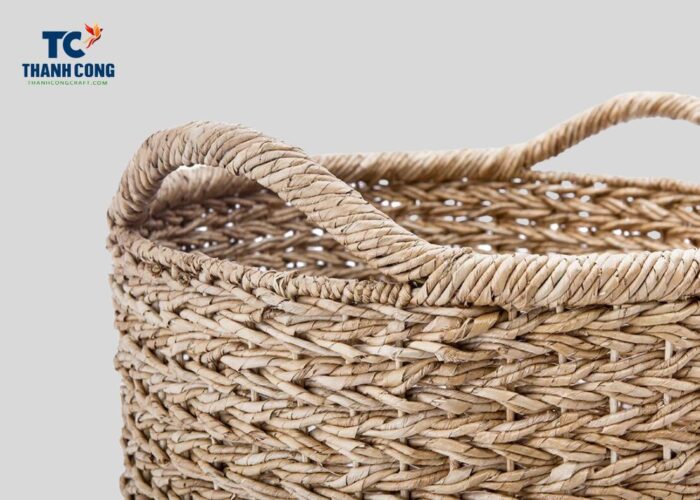
This seagrass weaving style has strong and long-lasting qualities. People use it to make baskets, lamps and carpets. This material is often woven on metal frames. As a result, it can provide reliability when applying objects in space. Although a metal frame is not required for all twisted seagrass baskets, it will assist maintain the basket’s robustness.
1.2 Split Seagrass
Split seagrass is a popular seagrass weaving pattern. It is manufactured from dried seagrass. Because the machine allows for uniformity in the splitting process width, people split into long thin threads by the machine
Seagrass is still a robust substance despite being sliced in half. Seagrass is an extremely durable material. However, without an iron frame, this material will struggle to retain large goods for an extended period of time. Customers must therefore consider the intended use while purchasing.
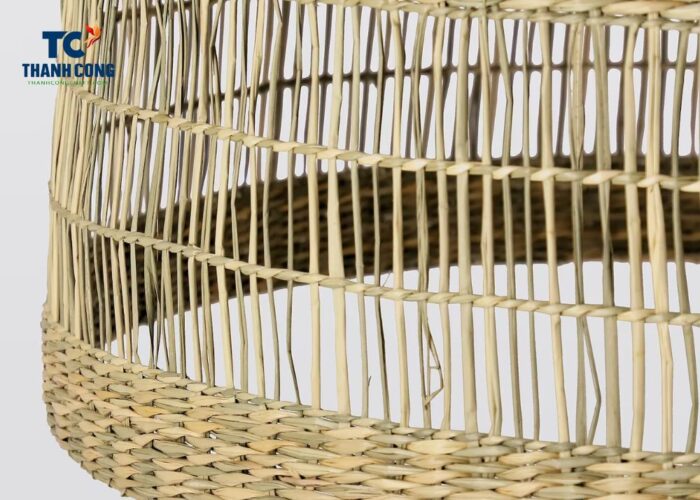
1.3 Braided Seagrass
This is also one of the seagrass varieties with a prominent seagrass weaving form. Skilled artisans use it to produce lovely, rustic goods. Braided sedge is made up of numerous strands of seagrass braided together. It resembles twisted seagrass in appearance, but the technique of manufacture is different.
Braided seagrass is knitted in a variety of diameters and braid designs. Of these, three or five braids are the most popular.. Because home décor wholesalers frequently create baskets without iron frames, production time for products made with this material is usually short.
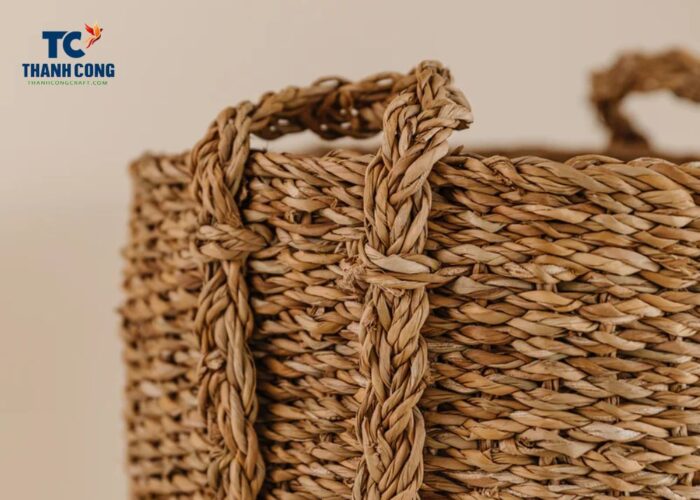
1.4 Pressed Seagrass
Seagrass fibers that have been crushed or flattened by machine and then knitted into various products. Despite its lightness and softness, pressed seagrass is quite durability. Products manufactured from pressed seagrass, on the other hand, will not be able to retain heavy objects within if they are not braided with a metal frame.
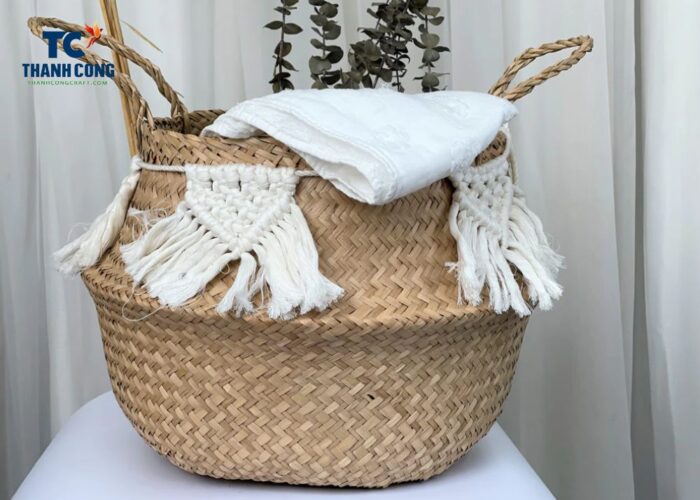
You can see this type of seagrass weaving on many products such as baskets, planters, bags, packs, shopping bags, etc. One of the most popular items is the sedge belly basket. Pressed seagrass products usually have a natural hue.
1.5 Coiled Seagrass
Coiled seagrass that has been rolled and bundled together. Because it is thick, it was similar in appearance to rattan products. Grass weaving techniques, on the other hand, is frequently braided with plastic string to produce color diversity. Seagrass with plastic string is the collective term for such items. You can also rely on this feature to distinguish if you are unable to touch the merchandise.
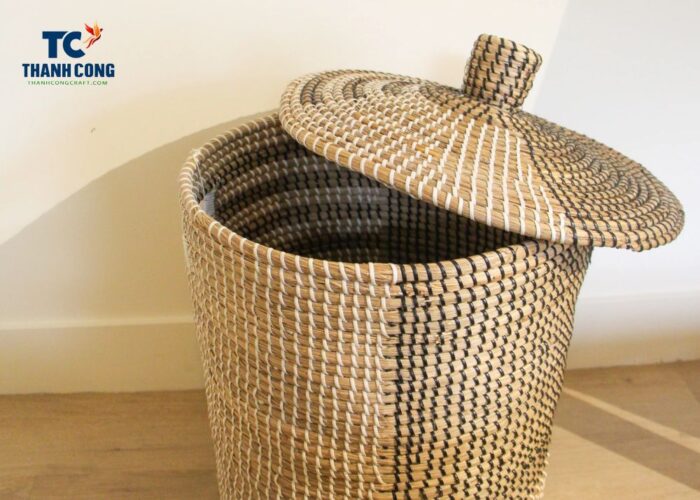
The benefit of coiled seagrass woven yarn is undeniable. It can hold heavy goods for an extended period. As a result, they’re frequently used to build huge storage baskets. It’s also utilized to create one-of-a-kind wall hangings that won’t bend or deform with age.
1.6 Wrapped Seagrass
This seagrass wrapping technique is similar to the twisting or braiding of seagrass. Wrapping sedge, on the other hand, is usually a method of creating a product by wrapping plastic rope around seagrass and then knitting or joining the ropes together neatly into goods.
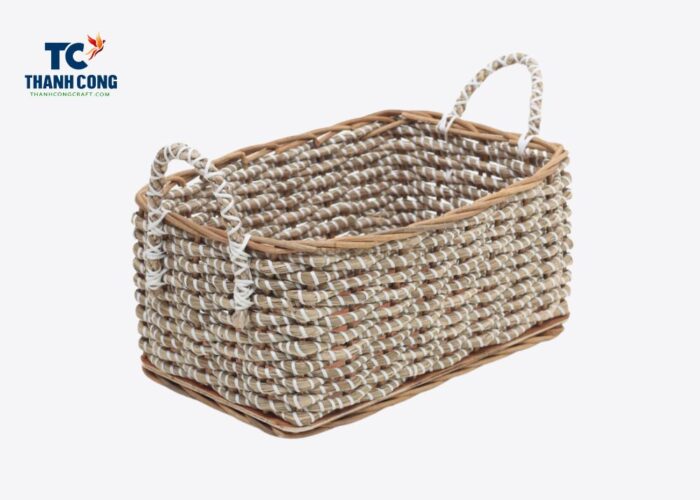
In items with seagrass wrapped, people often use rattan frames to replace metal frames. Wrapped seagrass is similar to rolled seagrass in terms of thickness and durability. The products manufactured from these two seagrass weaves are frequently fairly costly. Because the material includes both sedge and plastic rope. Because more complicated knitting techniques are required, the product’s worth is likewise higher.
2. How to Weave A Seagrass Basket?
Weaving a seagrass basket is a captivating craft that allows you to blend natural elements with your creativity. Here is how to weave a seagrass basket step by step.
Materials Needed:
- Seagrass Strands: Obtain seagrass strands, which are flexible and commonly used for basket weaving.
- Base Material: Choose a sturdy material for the base of your basket. This could be cardboard, a wooden base, or any other material that provides a solid foundation.
- Scissors: To trim and cut seagrass strands.
- Needle or Bodkin: A tool to assist in weaving strands through the base.
Step 1: Prepare the Base
Begin by preparing the base of your basket. If you’re using cardboard, cut it into the desired shape and size. Ensure that it’s sturdy enough to support the weaving process. A robust base lays the groundwork for a well-crafted seagrass basket, providing stability for the intricate weaving that follows.
Step 2: Soak the Seagrass
In this crucial step, immerse the seagrass strands in water for a duration of approximately 20 to 30 minutes. As the seagrass absorbs water, it becomes more supple, enhancing its adaptability to the contours of the base and contributing to the overall craftsmanship of the seagrass basket.
Step 3: Start Weaving
Take the first strand of seagrass and carefully position it on the prepared base. Secure it firmly by either tying a knot or skillfully weaving it through the base material. Ensure the strand is taut and properly anchored to create a stable starting point for your seagrass basket. This will serve as the starting point for your basket.
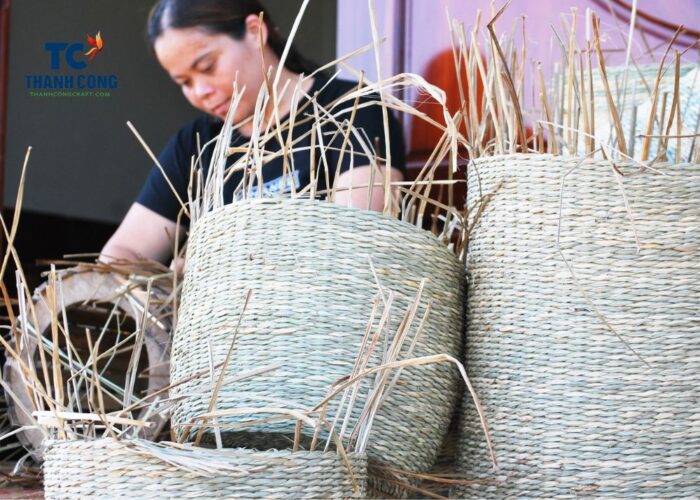
Step 4: Weave in a Spiral
Continue weaving the seagrass strands in a spiral pattern around the starting point. Keep the strands tight and close together to form a sturdy structure. Use the needle or bodkin to help guide the strands through the base.
Step 5: Add New Strands
As you weave, periodically add new strands of seagrass by overlapping the ends of the old and new strands. This creates a seamless transition, and the overlapping points can be hidden within the weaving.
Step 6: Build Height
Continue weaving to elevate the height of your seagrass basket. With each added strand, shape the form according to your vision. Keep the weave tight for structural integrity. This step is an opportunity for creative exploration – experiment with different patterns to enhance the visual appeal.
Step 7: Finish the Rim
After reaching your desired height, finalize your seagrass basket by giving attention to the rim. Secure the ends of the seagrass strands, trim any excess carefully, and neatly tuck them into the weaving. This final touch ensures a polished and durable finish, completing your woven seagrass masterpiece.
Step 8: Allow to Dry
In this concluding step, patience becomes your ally. Allow your seagrass basket to air-dry completely. As the basket dries, the seagrass undergoes a transformative process—it tightens and settles into a firm, durable structure. This crucial drying phase ensures that your basket retains its shape and strength, creating a finished product that not only captivates with its aesthetic appeal but also stands the test of time.
3. FAQs
3.1 Best Grass for Weaving
Sweetgrass is the best grass for weaving because it has long, slender blades with a soft texture, making it easy to work with for weaving.
Due to its high durability and versatility, sweetgrass can be used for a wide range of weaving projects, including baskets, hats, mats, and even small decorative items.
This material is also known for its pleasant fragrance and was often used in Native American basket weaving.
3.2 Do You Soak Seagrass Before Weaving?
Avoid soaking seagrass, as it is naturally flexible, and unnecessary soaking may cause it to unravel. Seagrass features slender stems that grow erect, reaching a height of 1-2m.
When weaving, align the ends on the back side without attempting to tuck or hide them, considering seagrass’s bulkiness. For added variety, consider weaving seagrass with another filler, such as reed.
3.3 How to Dry Grass for Basket Weaving?
To prepare grass for basket weaving, select fresh, soft, and flexible seagrass. How to dry grass for basket weaving? Lay the grass out on a mesh frame or newspaper to air-dry. Place the mesh frame in a sunny outdoor spot, or if available, hang bundled grass in a well-ventilated area like a barn. Allow the grass to dry for 2 to 4 weeks, depending on the grass type and weather conditions.
Regularly inspect for signs of mold or sun damage during the drying process. Once the grass is thoroughly dry, you can start weaving baskets to your liking. For added creativity, consider dyeing the grass by immersing it in a food coloring solution for 10 to 15 minutes.
In conclusion, learning how to weave a seagrass basket is a rewarding and eco-friendly venture that adds both functionality and aesthetic appeal to your crafting repertoire. By following the steps outlined in this guide, you’ve embarked on a journey to master the art of weaving seagrass, transforming it into a beautifully crafted basket.
If you have any further questions, don’t hesitate to send thanhcongcraft an email us at info@thanhcongcraft.com or message us at WhatsApp: +84967485411. Hope to serve you soon! Best regard!


